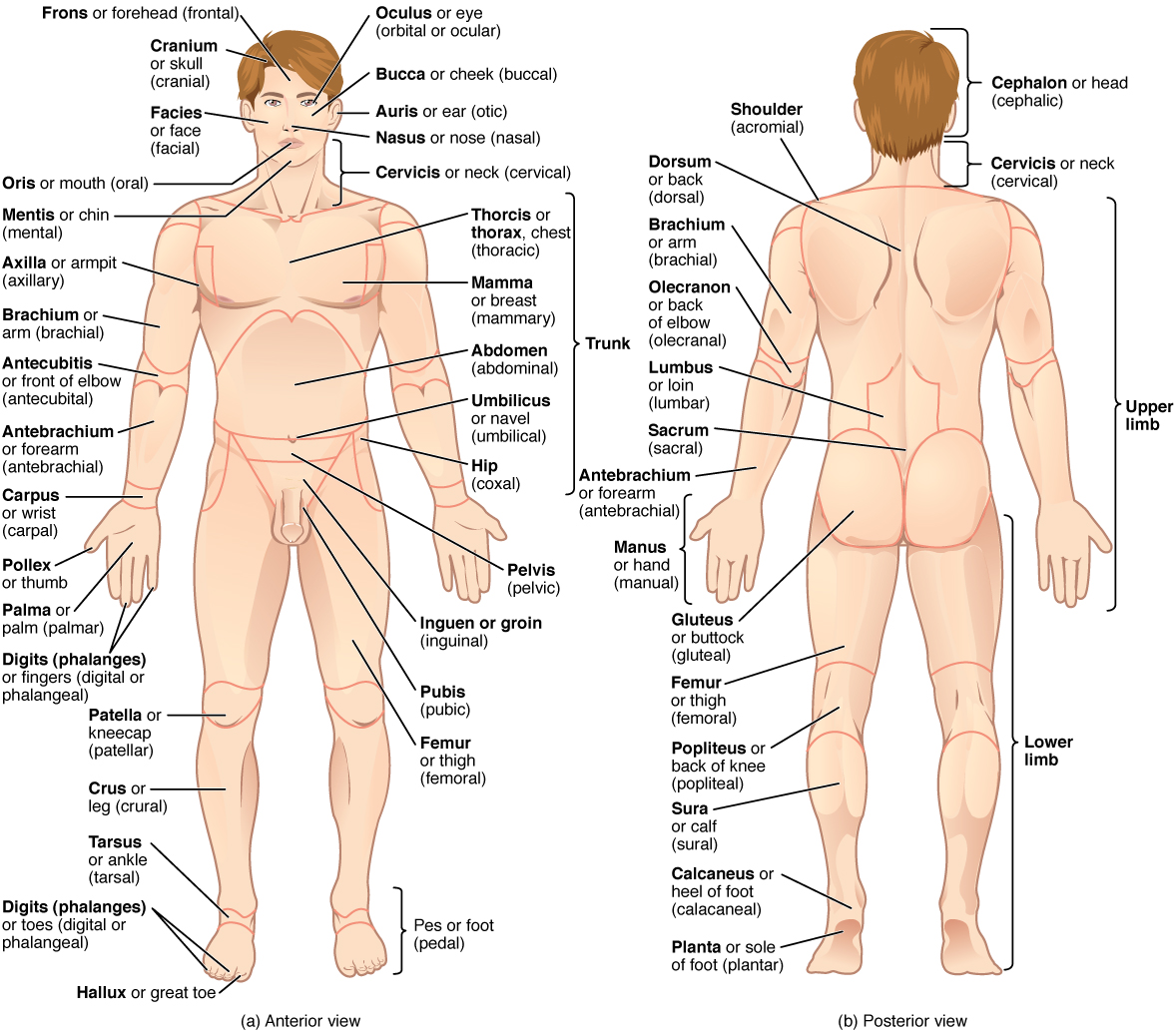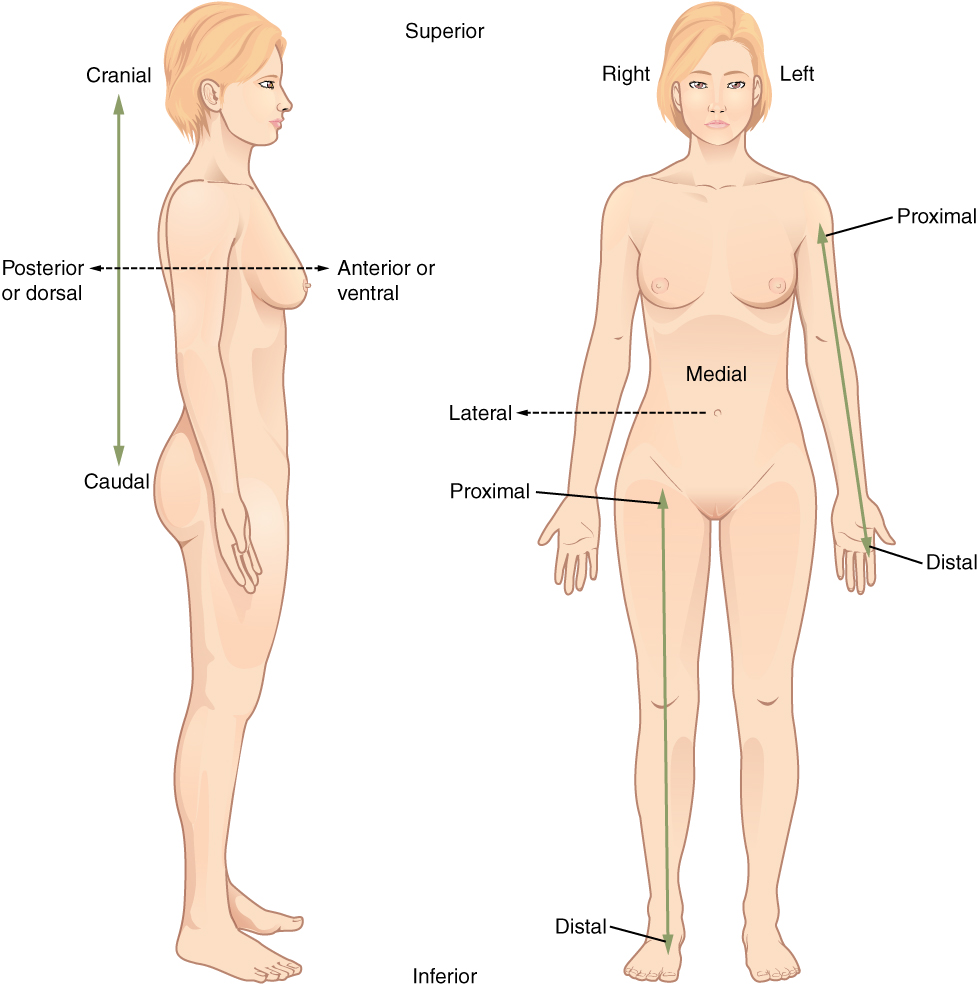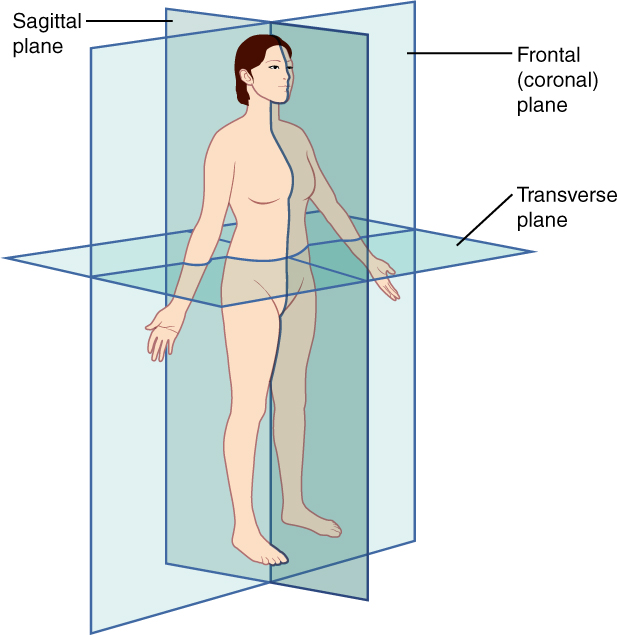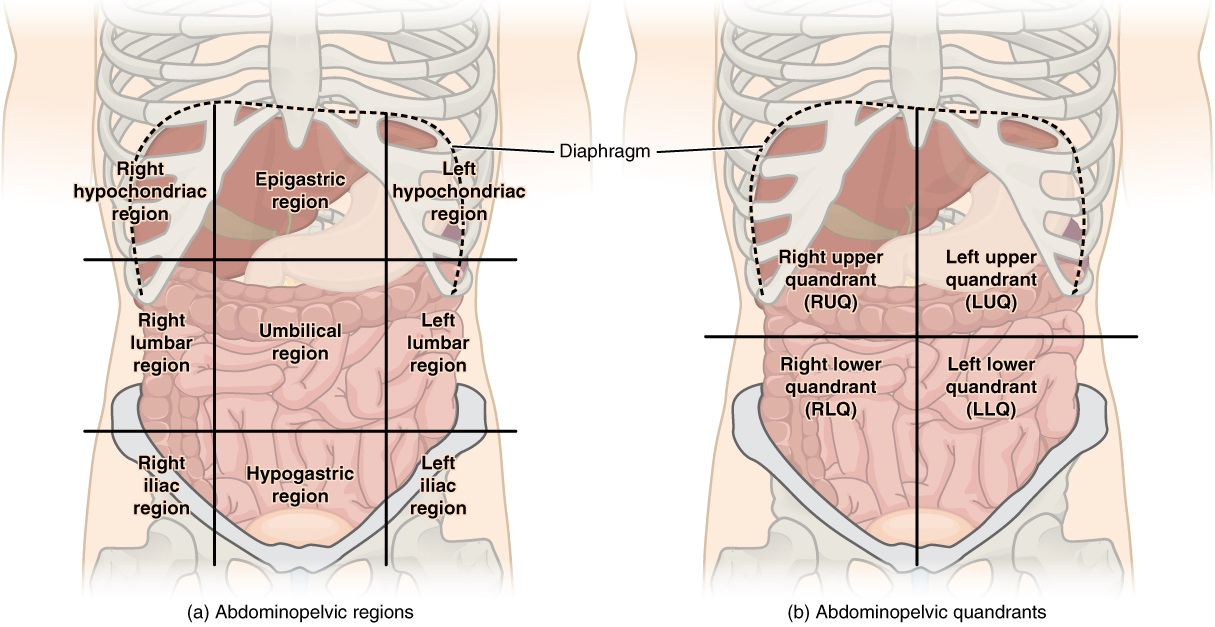Chapter 1. An Introduction to the Human Body
1.4 Anatomical Terminology
Learning Objectives
By the end of this section, you will be able to:
- Use appropriate anatomical terminology to identify key body structures, body regions, and directions in the body
- Demonstrate the anatomical position
- Describe the human body using directional and regional terms
- Identify three planes most commonly used in the study of anatomy
- Distinguish between major body cavities
Anatomists and health care providers use terminology that can be bewildering to the uninitiated; however, the purpose of this language is not to confuse but rather to increase precision and reduce medical errors. For example, is a scar “above the wrist” located on the forearm two or three inches away from the hand? Or is it at the base of the hand? Is it on the palm side or backside? By using precise anatomical terminology, we eliminate ambiguity. For example, you might say a scar “on the anterior antebrachium 3 inches proximal to the carpus.” Anatomical terms are derived from ancient Greek and Latin words. Because these languages are no longer used in everyday conversation, the meanings of their words do not change.
Anatomical terms are made up of roots, prefixes, and suffixes. The root of a term often refers to an organ, tissue, or condition, whereas the prefix or suffix often describes the root. For example, in the disorder hypertension, the prefix “hyper-” means “high” or “over,” and the root word “tension” refers to pressure, so the word “hypertension” refers to abnormally high blood pressure.
Anatomical Position
To further increase precision, anatomists standardize the way in which they view the body. Just as maps are normally oriented with north at the top, the standard body “map,” or anatomical position, is that of the body standing upright, with the feet at shoulder width and parallel, toes forward. The upper limbs are held out to each side, and the palms of the hands face forward as illustrated in Figure 1.4.1. Using this standard position reduces confusion. It does not matter how the body being described is oriented; the terms are used as if it is in anatomical position. For example, a scar in the “anterior (front) carpal (wrist) region” would be present on the palm side of the wrist. The term “anterior” would be used even if the hand were palm down on a table.

A body that is lying down is described as either prone or supine. Prone describes a face-down orientation, and supine describes a face-up orientation. These terms are sometimes used in describing the position of the body during specific physical examinations or surgical procedures.
Regional Terms
The human body’s numerous regions have specific terms to help increase precision (see Figure 1.4.1). Notice that the term “brachium” or “arm” is reserved for the upper arm, and “antebrachium” or “forearm” is used instead of “lower arm.” Similarly, “femur” or “thigh” is correct for the upper leg, and “leg” or “crus” is reserved for the portion of the lower limb between the knee and the ankle. You will be able to describe the body’s regions using the terms from the figure.
Directional Terms
Certain directional anatomical terms appear throughout this and any other anatomy textbook (Figure 1.4.2). These terms are essential for describing the relative locations of different body structures. For instance, an anatomist might describe one band of tissue as “inferior to” another or a physician might describe a tumor as “superficial to” a deeper body structure. Commit these terms to memory to avoid confusion when you are studying or describing the locations of particular body parts.
- Anterior (or ventral) describes the front or direction toward the front of the body. The toes are anterior to the foot.
- Posterior (or dorsal) describes the back or direction toward the back of the body. The popliteus is posterior to the patella.
- Superior (or cranial) describes a position above or higher than another part of the body proper. The orbits are superior to the oris.
- Inferior (or caudal) describes a position below or lower than another part of the body proper, near or toward the tail (in humans, the coccyx, or lowest part of the spinal column). The pelvis is inferior to the abdomen.
- Lateral describes the side or direction toward the side of the body. The thumb (pollex) is lateral to the digits.
- Medial describes the middle or direction toward the middle of the body. The hallux is the medial toe.
- Proximal describes a position in a limb that is nearer to the point of attachment or the trunk of the body. The brachium is proximal to the antebrachium.
- Distal describes a position in a limb that is farther from the point of attachment or the trunk of the body. The crus is distal to the femur.
- Superficial describes a position closer to the surface of the body. The skin is superficial to the bones.
- Deep describes a position farther from the surface of the body. The brain is deep to the skull.

Body Planes
A section is a two-dimensional surface of a three-dimensional structure that has been cut. Modern medical imaging devices enable clinicians to obtain “virtual sections” of living bodies. We call these scans. Body sections and scans can be correctly interpreted only if the viewer understands the plane along which the section was made. A plane is an imaginary two-dimensional surface that passes through the body. There are three planes commonly referred to in anatomy and medicine, as illustrated in Figure 1.4.3.
- The sagittal plane divides the body or an organ vertically into right and left sides. If this vertical plane runs directly down the middle of the body, it is called the midsagittal or median plane. If it divides the body into unequal right and left sides, it is called a parasagittal plane or, less commonly, a longitudinal section.
- The frontal plane divides the body or an organ into an anterior (front) portion and a posterior (rear) portion. The frontal plane is often referred to as a coronal plane (“corona” is Latin for “crown”).
- The transverse (or horizontal) plane divides the body or organ horizontally into upper and lower portions. Transverse planes produce images referred to as cross sections.

Body Cavities
The body maintains its internal organization by means of membranes, sheaths, and other structures that separate compartments. The main cavities of the body include the cranial, thoracic, and abdominopelvic (also known as the peritoneal) cavities. The cranial bones create the cranial cavity where the brain sits. The thoracic cavity is enclosed by the rib cage and contains the lungs and the heart, which is located in the mediastinum. The diaphragm forms the floor of the thoracic cavity and separates it from the more inferior abdominopelvic/peritoneal cavity. The abdominopelvic/peritoneal cavity is the largest cavity in the body. Although no membrane physically divides the abdominopelvic cavity, it can be useful to distinguish between the abdominal cavity (the division that houses the digestive organs) and the pelvic cavity (the division that houses the organs of reproduction).
Abdominal Regions and Quadrants
To promote clear communication about, for instance, the location of a patient’s abdominal pain or a suspicious mass, health care providers typically divide up the cavity into either nine regions or four quadrants (Figure 1.4.4).

The more detailed regional approach subdivides the cavity with one horizontal line immediately inferior to the ribs, one horizontal line immediately superior to the pelvis, and two vertical lines drawn as if dropped from the midpoint of each clavicle (collarbone). There are nine resulting regions. The simpler quadrants approach, which is more commonly used in medicine, subdivides the cavity with one horizontal and one vertical line that intersect at the patient’s umbilicus (navel).
Section Review
Ancient Greek and Latin words are used to build anatomical terms. A standard reference position for mapping the body’s structures is the normal anatomical position. Regions of the body are identified using terms such as “occipital” that are more precise than common words and phrases such as “the back of the head.” Directional terms such as anterior and posterior are essential for accurately describing the relative locations of body structures. Images of the body’s interior commonly align along one of three planes: the sagittal, frontal, or transverse.
Review Questions
Critical Thinking Questions
Glossary
- abdominopelvic cavity or peritoneal cavity
- the body cavity that contains both the abdominal and pelvic organs and is located inferior to the diaphragm
- abdominal cavity
- the portion of the abdominopelvic cavity that houses the digestive organs
- abdominal quadrants
- four sections of the abdomen divided by a horizontal and a vertical line intersecting at the umbilicus
- abdominal regions
- nine sections of the abdomen defined by four lines to describe the location of pain or organs more precisely
- anatomical position
- the standard body position used for reference, with the body upright, feet shoulder-width apart, arms at sides, and palms facing forward
- anterior
- the front or direction toward the front of the body
- body cavity
- a space within the body that contains and protects internal organs
- caudal
- a direction toward the tail or lower part of the body
- coronal plane
- a vertical plane that divides the body into anterior and posterior portions; also called the frontal plane
- cranial cavity
- the space within the skull that houses the brain
- deep
- a position farther from the surface of the body
- distal
- a position in a limb that is farther from the point of attachment or trunk of the body
- dorsal
- the back or direction toward the back of the body
- frontal plane
- a vertical plane that divides the body into front and back parts; also called the coronal plane
- horizontal plane
- a plane that divides the body into upper and lower portions; also known as the transverse plane
- inferior
- a position below or further from the head than another part of the body in a bipedal organism
- lateral
- the side or direction toward the side of the body
- medial
- the middle or direction toward the middle of the body
- mediastinum
- the central compartment of the thoracic cavity containing the heart, esophagus, and other structures
- midsagittal plane
- a vertical plane that divides the body into equal right and left halves
- parasagittal plane
- a vertical plane that divides the body into unequal right and left sides
- pelvic cavity
- the portion of the abdominopelvic cavity that houses the reproductive organs
- plane
- an imaginary flat surface used to divide the body or an organ for reference
- posterior
- the back or direction toward the back of the body
- prone
- a face-down body position
- proximal
- a position in a limb that is nearer to the point of attachment or trunk of the body
- sagittal plane
- a vertical plane that divides the body into right and left sides
- section
- a two-dimensional surface of a three-dimensional body structure that has been cut
- superficial
- a position closer to the surface of the body
- superior
- a position above or closer to the head than another part of the body in a bipedal organism
- supine
- a face-up body position
- thoracic cavity
- the body cavity located in the chest that contains the lungs and heart
- transverse plane
- a horizontal plane that divides the body into upper and lower parts
- ventral
- the front or direction toward the front of the body
Glossary Flashcards
This work, Human Physiology, is adapted from Anatomy & Physiology by OpenStax, licensed under CC BY. This edition, with revised content and artwork, is licensed under CC BY-SA except where otherwise noted.
Images from Anatomy & Physiology by OpenStax are licensed under CC BY except where otherwise noted.
Access the original for free at OpenStax.
Image Descriptions
Figure 1.4.1. This illustration shows an anterior and posterior view of the human body. The cranial region encompasses the upper part of the head while the facial region encompasses the lower half of the head beginning below the ears. The eyes are referred to as the ocular region. The cheeks are referred to as the buccal region. The ears are referred to as the auricle or otic region. The nose is referred to as the nasal region. The chin is referred to as the mental region. The neck is referred to as the cervical region. The trunk of the body contains, from superior to inferior, the thoracic region encompassing the chest, the mammary region encompassing each breast, the abdominal region encompassing the stomach area, the coxal region encompassing the belt line, and the pubic region encompassing the area above the genitals. The umbilicus, or naval, is located at the center of the abdomen. The pelvis and legs contain, from superior to inferior, the inguinal or groin region between the legs and the genitals, the pubic region surrounding the genitals, the femoral region encompassing the thighs, the patellar region encompassing the knee, the crural region encompassing the lower leg, the tarsal region encompassing the ankle, the pedal region encompassing the foot and the digital/phalangeal region encompassing the toes. The great toe is referred to as the hallux. The regions of the upper limbs, from superior to inferior, are the axillary region encompassing the armpit, the brachial region encompassing the upper arm, the antecubital region encompassing the front of the elbow, the antebrachial region encompassing the forearm, the carpal region encompassing the wrist, the palmar region encompassing the palm, and the digital/phalangeal region encompassing the fingers. The thumb is referred to as the pollux. The posterior view contains, from superior to inferior, the cervical region encompassing the neck, the dorsal region encompassing the upper back and the lumbar region encompassing the lower back. The regions of the back of the arms, from superior to inferior, include the cervical region encompassing the neck, acromial region encompassing the shoulder, the brachial region encompassing the upper arm, the olecranal region encompassing the back of the elbow, the antebrachial region encompasses the back of the arm, and the manual region encompassing the palm of the hand. The posterior regions of the legs, from superior to inferior, include the gluteal region encompassing the buttocks, the femoral region encompassing the thigh, the popliteus region encompassing the back of the knee, the sural region encompassing the back of the lower leg, and the plantar region encompassing the sole of the foot. Some regions are combined into larger regions. These include the trunk, which is a combination of the thoracic, mammary, abdominal, naval, and coxal regions. The cephalic region is a combination of all of the head regions. The upper limb region is a combination of all of the arm regions. The lower limb region is a combination of all of the leg regions. [Return to Figure 1.4.1]
Figure 1.4.2. This illustration shows two diagrams: one of a side view of a female and the other of an anterior view of a female. Each diagram shows directional terms using double-sided arrows. The cranial-distal arrow runs vertically behind the torso and lower abdomen. The cranial arrow is pointing toward the head while the caudal arrow is pointing toward the tail bone. The posterior/anterior arrow is running horizontally through the back and chest. The posterior or dorsal arrow is pointing toward the back while the anterior, or ventral arrow, is pointing toward the abdomen. On the anterior view, the proximal/distal arrow is on the right arm. The proximal arrow is pointing up toward the shoulder while the distal arrow is pointing down toward the hand. The lateral-medial arrow is a horizontal arrow on the abdomen. The medial arrow is pointing toward the navel while the lateral arrow is pointing away from the body to the right. Right refers to the right side of the woman’s body from her perspective while left refers to the left side of the woman’s body from her perspective. [Return to Figure 1.4.2]
Figure 1.4.3. This illustration shows a female viewed from her right, front side. The anatomical planes are depicted as blue rectangles passing through the woman’s body. The frontal or coronal plane enters through the right side of the body, passes through the body, and exits from the left side. It divides the body into front (anterior) and back (posterior) halves. The sagittal plane enters through the back and emerges through the front of the body. It divides the body into right and left halves. The transverse plane passes through the body perpendicular to the frontal and sagittal planes. This plane is a cross section which divides the body into upper and lower halves. [Return to Figure 1.4.3]
Figure 1.4.4. This illustration has two parts. Part A shows the abdominopelvic regions. These regions divide the abdomen into nine squares. The upper right square is the right hypochondriac region and contains the base of the right ribs. The upper left square is the left hypochondriac region and contains the base of the left ribs. The epigastric region is the upper central square and contains the bottom edge of the liver as well as the upper areas of the stomach. The diaphragm curves like an upside down U over these three regions. The central right region is called the right lumbar region and contains the ascending colon and the right edge of the small intestines. The central square contains the transverse colon and the upper regions of the small intestines. The left lumbar region contains the left edge of the transverse colon and the left edge of the small intestine. The lower right square is the right iliac region and contains the right pelvic bones and the ascending colon. The lower left square is the left iliac region and contains the left pelvic bone and the lower left regions of the small intestine. The lower central square contains the bottom of the pubic bones, upper regions of the bladder and the lower region of the small intestine. Part B shows four abdominopelvic quadrants. The right upper quadrant (RUQ) includes the lower right ribs, right side of the liver, and right side of the transverse colon. The left upper quadrant (LUQ) includes the lower left ribs, stomach, and upper left area of the transverse colon. The right lower quadrant (RLQ) includes the right half of the small intestines, ascending colon, right pelvic bone and upper right area of the bladder. The left lower quadrant (LLQ) contains the left half of the small intestine and left pelvic bone. [Return to Figure 1.4.4]
Report an Error
Did you find an error, typo, broken link, or other problem in the text? Please follow this link to the error reporting form to submit an error report to the authors.
